Your vehicle’s engine cooling system is key to keeping your car running well. Engines get very hot when they work. If this heat isn’t managed, it can cause big problems and expensive fixes.
The cooling system in your Toyota uses special fluid to keep the engine cool. This fluid takes heat away from important parts. It stops the engine from getting too hot, which could damage it.
Many people don’t realize how important this system is until it breaks down. In fact, many engine failures are due to cooling issues. These problems could have been avoided with regular care.
Keeping your cooling system in good shape is more than just avoiding breakdowns. It’s about keeping your car running well and lasting longer. Whether you have a Camry, Corolla, RAV4, or Tacoma, knowing about this is crucial.
In this guide, we’ll cover how the system works and how to maintain it. You’ll learn how to keep your engine at the right temperature. This is useful for both DIY fans and those who prefer professional help.
Understanding Your Toyota Coolant System
Knowing how your Toyota’s coolant system works is key to keeping it running right. It keeps your engine cool, no matter the weather. Without it, your engine could overheat, leading to expensive repairs.
Components of the Cooling System
Your Toyota’s cooling system has many parts that work together. Each one is important for keeping the system running smoothly.
The radiator is the main heat exchanger. It cools the coolant and sends it into the air. The water pump is connected to the radiator. It circulates the coolant through the engine.
The thermostat controls how much coolant flows. It stays closed when it’s cold and opens as it warms up. Coolant hoses connect these parts, helping the fluid move around the system.
The coolant reservoir holds extra fluid. Cooling fans help move air when it gets too hot.
How the Cooling System Works
When your engine heats up, the coolant starts moving. It’s a mix of antifreeze and water that absorbs the heat.
As the coolant gets hotter, the thermostat opens. This lets the hot fluid go to the radiator. The radiator cools it down before it goes back to the engine.
This keeps your engine at the right temperature. Modern Toyotas also have electronic controls to make cooling more efficient.
Types of Toyota Cooling Systems
Toyota has different cooling systems for their cars. Knowing which one your car has is important for taking care of it.
| System Type | Common Models | Key Features | Maintenance Considerations |
|---|---|---|---|
| Conventional | Older Camry, Corolla, Tacoma | Belt-driven water pump, mechanical thermostat | Regular belt inspection, standard coolant flush intervals |
| Electronic | Newer RAV4, Highlander | Electronically controlled thermostat, variable speed fans | Requires diagnostic equipment for some services |
| Hybrid | Prius, Camry Hybrid, RAV4 Hybrid | Dual cooling circuits (engine and inverter) | Special coolant requirements, additional components |
| Performance | GR86, Supra | Enhanced cooling capacity, additional oil coolers | Higher coolant pressure, more frequent inspections |
Hybrid Toyotas have special cooling systems. They manage both the engine and electric parts. These systems need extra care during maintenance to work right.
The Importance of Proper Coolant Maintenance
Your Toyota’s cooling system is key to its health. It affects your car’s reliability, efficiency, and lifespan. Regular maintenance is more than just a task—it’s a vital investment to protect your engine.
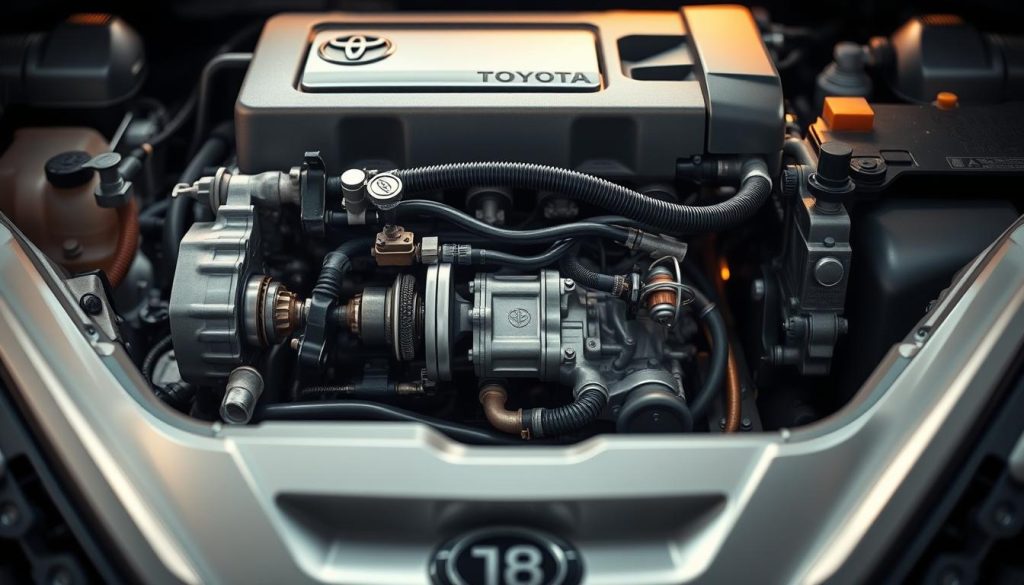
Preventing Engine Damage
Your Toyota’s engine gets very hot when it runs. Temperatures can hit 2,000°F and even more in extreme cases. Since aluminum parts melt at 1,225°F, effective overheating prevention is crucial.
Without the right coolant care, you face big risks. These include:
- Warped cylinder heads
- Cracked engine blocks
- Blown head gaskets
- Seized engine components
Optimizing Fuel Efficiency
A good cooling system keeps your Toyota at the right temperature. If it’s too hot or cold, it uses more fuel. Regular antifreeze service helps keep it just right, saving gas and cutting emissions.
Extending Engine Life
Fresh coolant has additives that fight corrosion in your engine. These additives wear out over time, leaving your engine at risk.
Sticking to Toyota’s coolant maintenance schedule is more than avoiding breakdowns. It’s about keeping your car valuable and running longer. It’s like preventive medicine that saves you money later on.
Types of Coolant for Toyota Vehicles
Choosing the right coolant for your Toyota is key to keeping your engine running smoothly. Toyota coolants are made to protect against corrosion, freezing, and overheating. They work well with Toyota engines.
Toyota Super Long Life Coolant (Pink/Red)
Toyota Super Long Life Coolant (SLLC) is the latest in coolant technology. It’s easy to spot because of its pink or red color. Most Toyotas made after 2004 use this premium coolant.
This coolant is special because it uses organic acid technology (OAT). It offers superior protection against corrosion, especially for aluminum parts in modern engines. You’ll need to replace it every 100,000 miles or 10 years, whichever comes first.
Toyota Long Life Coolant (Red)
Before SLLC, Toyota used Long Life Coolant (LLC) in cars from the late 1990s to early 2000s. This red coolant still protects well but doesn’t last as long as SLLC.
LLC needs to be replaced every 30,000 to 50,000 miles. It’s good but not as long-lasting as SLLC. If your Toyota has LLC, you might want to switch to SLLC next time you get your antifreeze service.
Compatibility with Different Toyota Models
Each Toyota model needs its own coolant because of its engine and cooling system. For example, hybrid cars like the Prius have special coolants for their gasoline and electric parts.
Check your owner’s manual to find out what coolant your Toyota needs. Using the wrong coolant can hurt your engine’s cooling and damage parts.
OEM vs. Aftermarket Coolants
When it’s time to replace your coolant, you can choose between Toyota’s OEM coolants and aftermarket ones. Here are some things to think about:
| Factor | Toyota OEM Coolant | Aftermarket Coolant | What to Consider |
|---|---|---|---|
| Formulation | Specifically engineered for Toyota engines | General formulation that may meet Toyota specs | Engine protection level |
| Cost | Higher initial investment | Generally less expensive | Long-term value vs. upfront savings |
| Longevity | Predictable service life as specified by Toyota | Varies by brand and quality | Maintenance interval reliability |
| Warranty | Won’t void Toyota warranty | May affect warranty if problems arise | Warranty protection importance |
| Availability | Toyota dealerships and select auto parts stores | Widely available at most auto parts retailers | Convenience of purchase |
Identifying coolant types is easy by color. Green coolants need a change every two years or 30,000 miles. Toyota’s SLLC, in pink, red, orange, or gold, lasts up to five years or 100,000 miles.
It doesn’t matter which coolant you pick. Keeping coolant levels right and replacing it on time is key for your Toyota’s health and performance.
Essential Tools for Toyota Coolant System Maintenance
To service your Toyota’s cooling system, you’ll need some key tools and safety gear. The right tools make coolant replacement easier and keep you safe. Let’s look at what you need before starting this important task.
Basic Tools Every Toyota Owner Should Have
Every Toyota owner should have a basic toolkit for coolant maintenance. Start with standard and metric wrenches for loosening drain plugs and hose clamps. You’ll also need screwdrivers and pliers for different parts.
An automotive funnel is great for adding new coolant without spills. You’ll need a drain pan that can hold 1-2 gallons for a radiator flush. Don’t forget lots of shop rags for spills and cleaning.
A coolant hydrometer is key for checking coolant strength and condition. It helps decide if you need to replace coolant or not. This tool can save you from unnecessary coolant replacement and alert you to problems early.
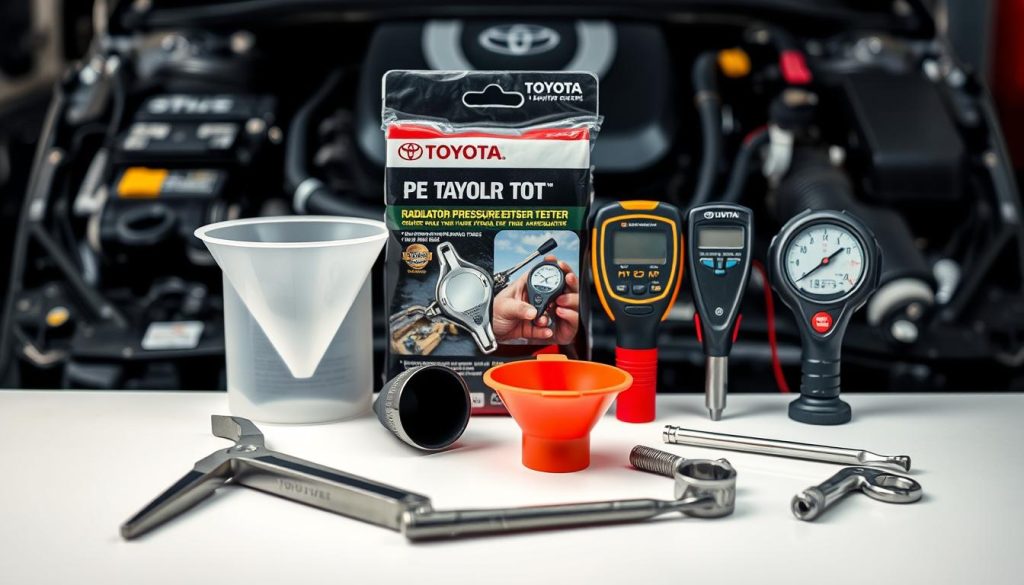
Optional Specialized Equipment
For deeper maintenance, think about specialized tools. A coolant flush kit connects to your radiator and uses your garden hose to clean the system. It removes old coolant and debris.
A vacuum coolant refiller helps get rid of air pockets when refilling. These air pockets can cause overheating if not removed. This tool is crucial for avoiding hot spots.
A cooling system pressure tester checks for leaks by pressurizing the system. It finds small leaks before they become big problems. This saves you from expensive repairs.
Safety Equipment and Precautions
Always prioritize safety when working with coolant. Wear chemical-resistant gloves to protect your skin from ethylene glycol. Safety glasses are key to protect your eyes from splashes.
Work only on a completely cool engine to avoid burns. Keep fresh water ready to rinse any skin contact with coolant.
Remember, coolant is highly toxic to humans and animals. Its sweet taste can attract pets. Store coolant in sealed containers out of reach of children and animals. Dispose of used coolant at authorized recycling centers, not on the ground or in storm drains.
How to Check Your Toyota’s Coolant Level
Checking your Toyota’s coolant level is easy and protects your engine. It helps avoid overheating and keeps your cooling system running well. Let’s see how to do it right and what to look for.
Finding the Coolant Reservoir in Different Toyota Models
The coolant reservoir spot changes in Toyotas. In Camry and Corolla sedans, it’s on the passenger side. For RAV4 SUVs and Tacoma trucks, it’s at the engine’s front.
Toyota reservoirs are usually white or clear with a blue or yellow cap. They say “COOLANT” or “ENGINE COOLANT.” If you can’t find it, your owner’s manual has diagrams for your model.
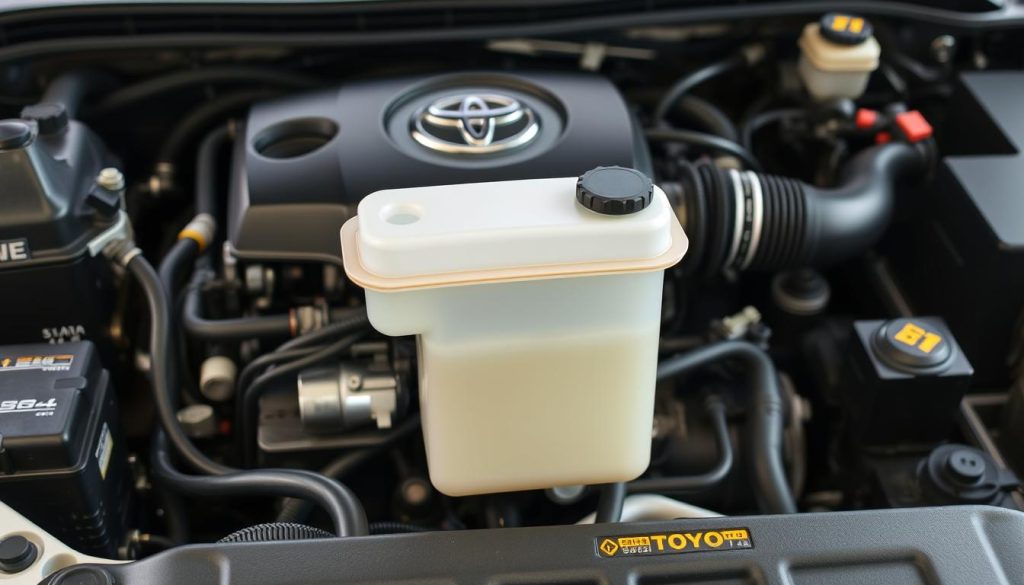
Reading the Level Indicators
Make sure your Toyota is parked on level ground and cool before checking the coolant. This avoids burns and gives a correct reading.
Look for “MIN” and “MAX” (or “LOW” and “FULL”) on the reservoir. The coolant should be between these marks, closer to “MAX” or “FULL.” If it’s below “MIN,” add the right coolant for your Toyota.
Checking Coolant Condition and Quality
The coolant’s condition matters as much as its level. Fresh coolant is bright and clear, often pink or red. If it’s rusty, brown, or has particles, it’s bad and needs flushing.
Use a coolant tester (hydrometer) from an auto parts store for a detailed check. In most U.S. climates, coolant should protect against -34°F. If it fails or looks old, flush it even if it’s not time yet.
Proper Coolant Mixing Ratios for Toyota Vehicles
The right coolant-to-water ratio in your Toyota is key to protecting your engine. A wrong mix can lead to cooling issues, damage, or even engine failure. Toyota has specific guidelines for coolant mixtures to keep your engine running well and safe from freezing and overheating.
Understanding Coolant-to-Water Ratios
Most Toyotas need a 50/50 coolant-to-water mix. This mix balances heat transfer and freeze protection. The coolant keeps the engine from freezing below -34°F and prevents overheating above 265°F.
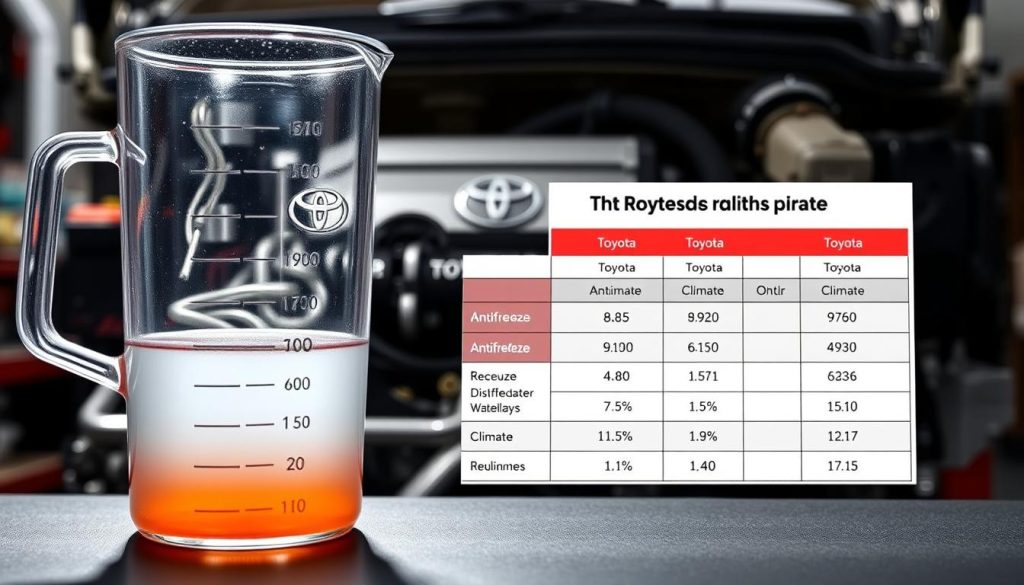
Don’t use tap water for coolant mix. Tap water can cause corrosion and damage. Use distilled or deionized water instead. The coolant also has additives to protect metal parts.
Using only water makes your engine vulnerable to freezing. Undiluted coolant doesn’t cool well and lacks protection.
Climate Considerations for U.S. Regions
Your location affects your Toyota’s coolant mix. In cold places like Minnesota, a 60/40 mix offers better freeze protection.
In warmer areas like Arizona, the 50/50 mix is still best. It keeps the engine cool and prevents corrosion in the heat.
| U.S. Region | Recommended Ratio | Freeze Protection | Boil-Over Protection | Special Considerations |
|---|---|---|---|---|
| Northern States | 60/40 (coolant/water) | Down to -62°F | Up to 275°F | Check more frequently in winter |
| Mid-Atlantic | 50/50 (coolant/water) | Down to -34°F | Up to 265°F | Standard year-round protection |
| Southern States | 50/50 (coolant/water) | Down to -34°F | Up to 265°F | Monitor during extreme heat waves |
| High Altitude Regions | 50/50 (coolant/water) | Down to -34°F | Up to 265°F | Lower boiling points require vigilance |
Pre-Mixed vs. Concentrate Options
There are pre-mixed and concentrate coolants for Toyotas. Pre-mixed is ready to use but costs more. Concentrate needs mixing but is cheaper and more flexible.
For concentrate, use a measuring container for accurate mixing. Always mix in a clean container to avoid contamination.
Choose the right coolant for your Toyota. The wrong one can harm gaskets and seals. Your owner’s manual will tell you what coolant to use, like Toyota Super Long Life Coolant or Toyota Long Life Coolant.
Step-by-Step Toyota Coolant Flush Procedure
The Toyota coolant flush process might seem hard, but it’s doable with the right steps. A radiator flush gets rid of old coolant and debris that can damage your engine. Follow these steps to keep your Toyota’s cooling system working well and extend its life.
Preparation Steps
Start by getting all the tools you need. You’ll need Toyota coolant, distilled water, a flush solution, a drain pan, funnel, and wrenches. Always wear gloves and safety glasses for protection.
Make sure your car is parked on flat ground and the engine is cool. Wait at least 2-3 hours after driving. You’ll need about 2-3 hours for the whole process to do it right.
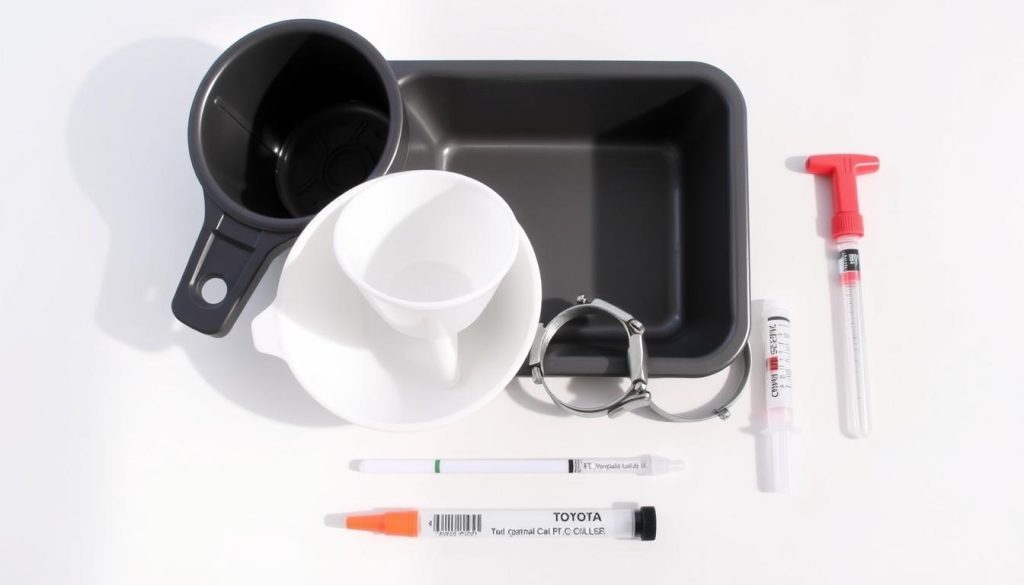
Draining the Old Coolant
Find the radiator drain plug at the bottom corner. Place a drain pan under it. Remove the radiator cap first to help the coolant flow. Then, open the drain plug and let all the coolant drain out.
Some Toyotas have an engine block drain plug too. Remove it for a complete drain. After draining, put back and tighten all plugs to avoid leaks.
Flushing the System
Fill the radiator with distilled water and a good flush solution. Put the radiator cap back, start the engine, and run the heater on high for 10-15 minutes. This cleans the system.
Turn off the engine and let it cool. Drain the solution as before. Do this 2-3 times until the water is clear.
Adding New Coolant
After flushing, make sure all plugs are tight. Use a funnel to add a 50/50 mix of Toyota coolant and distilled water. Check your manual for the exact mix.
Fill the coolant reservoir to the “MAX” line. Replace the cap, start the engine, and let it warm up with the heater on. This removes air from the system.
Post-Flush Checks and Verification
After the flush, check everything to make sure it’s working right. Look for leaks in hose connections and check the coolant level after driving a bit.
Make sure the temperature gauge is normal and the heater works well. Note the date and mileage in your maintenance log to keep track of your coolant flush schedule.
| Flush Method | Effectiveness | Time Required | Cost |
|---|---|---|---|
| Simple Drain & Fill | Low – Removes only 40-60% of old coolant | 30-45 minutes | $20-30 in materials |
| Standard Flush (water only) | Medium – Removes most old coolant | 1-2 hours | $30-50 in materials |
| Chemical Flush Solution | High – Removes coolant and deposits | 2-3 hours | $50-70 in materials |
| Professional Power Flush | Very High – Complete system cleaning | 1-2 hours (service time) | $100-200 at service center |
Toyota Coolant System Maintenance Schedule
Keeping up with your Toyota’s coolant system maintenance is key. Regular checks prevent overheating and keep your engine running smoothly. The schedule varies based on your car’s model and coolant type.
Not all coolants need to be changed at the same time. Silicate coolants should be replaced every two years or 30,000 miles. But, if you have Toyota’s Super Long Life Coolant, it can last up to five years or 100,000 miles.
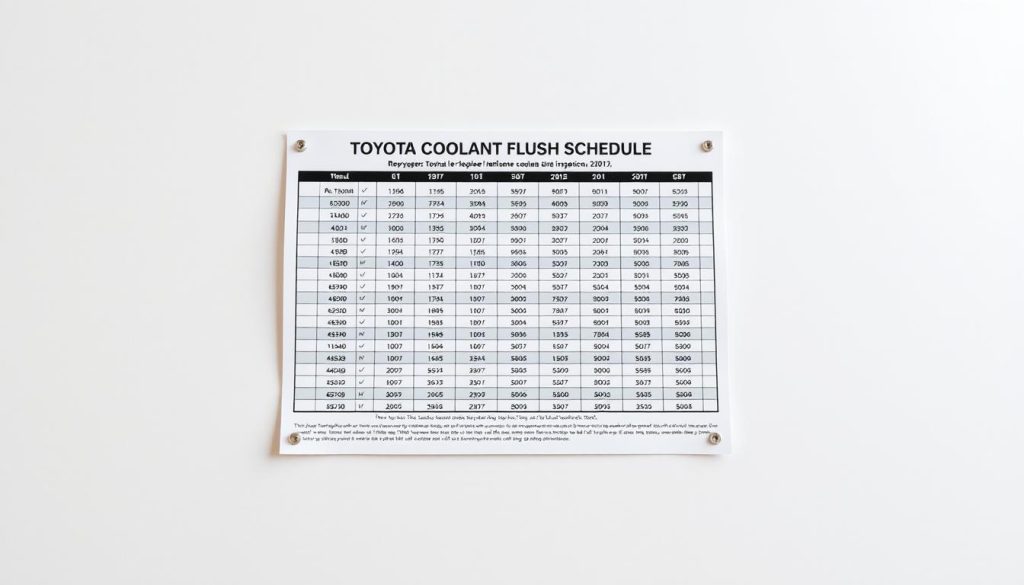
Recommended Intervals by Model
Toyota has specific coolant maintenance schedules for each model. Following these guidelines helps prevent overheating and keeps your engine in top shape.
| Toyota Model | Initial Replacement | Subsequent Replacements | Inspection Interval |
|---|---|---|---|
| Camry | 100,000 miles | Every 50,000 miles | Every service visit |
| Corolla | 100,000 miles | Every 50,000 miles | Every service visit |
| RAV4 | 100,000 miles | Every 50,000 miles | Every service visit |
| Tacoma | 60,000 miles | Every 60,000 miles | Every 15,000 miles |
Factors That Affect Maintenance Frequency
Several factors can change when you need to flush your coolant. Severe driving conditions can wear it down faster.
Driving in very hot or cold weather stresses your cooling system. If you often drive in temperatures over 90°F or below freezing, check your coolant more often.
Towing heavy loads or driving off-road also puts extra strain on your cooling system. If you tow a lot, especially in a Toyota Tacoma, follow the severe service schedule of every 60,000 miles.
Older cars with high mileage might need coolant service more often. If your Toyota has over 100,000 miles, consider shortening the coolant flush interval to keep it running well.
Tracking Your Maintenance History
Keeping a detailed maintenance log is important. It helps you stay on track with coolant service. You can use a notebook or a digital app for this.
Write down the date, mileage, coolant type, and if it was a full flush or just a top-off. Many people find it helpful to put a sticker in the engine bay with the last service date and mileage.
This detailed tracking is useful for any mechanic working on your car. It also shows you’ve taken good care of your vehicle, which can help when selling it.
Warning Signs of Toyota Coolant System Problems
Being aware of cooling system issues in your Toyota can stop overheating and engine damage. Your car’s cooling system sends out signals when it’s in trouble. Spotting these signs early helps avoid expensive repairs. It’s key to overheating prevention and keeping your car in good shape.
Temperature Gauge Abnormalities
Your Toyota’s temperature gauge is your first defense against overheating. If the needle goes up or wobbles, your engine cooling system might be failing.
On the other hand, a gauge that never gets to normal might have a stuck-open thermostat. Newer Toyotas with digital displays will show warning lights or messages for abnormal temperatures. Always take these warnings seriously and fix them fast.
Visible Leaks and Their Sources
Coolant leaks need quick action. Look under your car for bright-colored fluid (like pink, red, or green) with a sweet smell. Common leak spots include:
- Radiator seams or damaged fins
- Deteriorated hoses or loose clamps
- Water pump seal failures
- Heater core connections
- Damaged coolant reservoir
Even small leaks can cause low coolant levels and overheating. Fixing them quickly is crucial for overheating prevention.
Unusual Smells or Sounds
Your senses can warn you of cooling system problems before they get worse. A sweet smell (like maple syrup) inside or outside means leaking coolant. Foggy windows often mean a leaking heater core.
Starting your Toyota might make sounds like gurgling or bubbling from the radiator or reservoir. This could mean air in the system or a serious issue like a blown head gasket. Hissing sounds usually mean pressurized coolant is leaking from a small spot or the pressure cap.
Performance Issues Related to Cooling
Cooling system problems can also show up as performance issues in your Toyota. You might feel less power, especially when accelerating or going uphill. This is because the engine computer goes into “limp mode” to avoid heat damage.
Poor heater performance in cold weather often means low coolant levels or a clogged heater core. Using more fuel than usual can also happen if the engine runs too hot or too cold.
If your air conditioning isn’t working well, it might be because the engine cooling system is running too hot. This makes it harder for the A/C to cool. Any of these signs need quick attention to avoid serious damage to your Toyota’s engine.
Troubleshooting Common Toyota Coolant Issues
Spotting Toyota coolant system problems early can save you from big repairs. Knowing how to fix cooling issues is key. A step-by-step approach helps find and fix problems before they get worse.
Overheating Causes and Solutions
Overheating is very dangerous for your Toyota’s engine. If the temperature gauge goes into the red or you see steam, pull over and turn off the engine.
Common overheating reasons include:
- Low coolant level from leaks or evaporation
- A faulty thermostat (usually stuck closed)
- A malfunctioning water pump
- A clogged radiator or cooling passages
- A failed radiator fan
In an emergency, turn your heater on full blast to cool the engine. Never open the radiator cap when it’s hot. This can cause severe burns from the pressurized coolant.
Coolant Loss Investigation
If you keep adding coolant, you have a leak. Start by looking for leaks in all hoses, connections, and the radiator.
If you don’t see leaks, it might be an internal problem like a blown head gasket. Look for these signs:
- White smoke from the exhaust
- Milky substance in the oil (looks like mayonnaise)
- Bubbles in the radiator or overflow tank
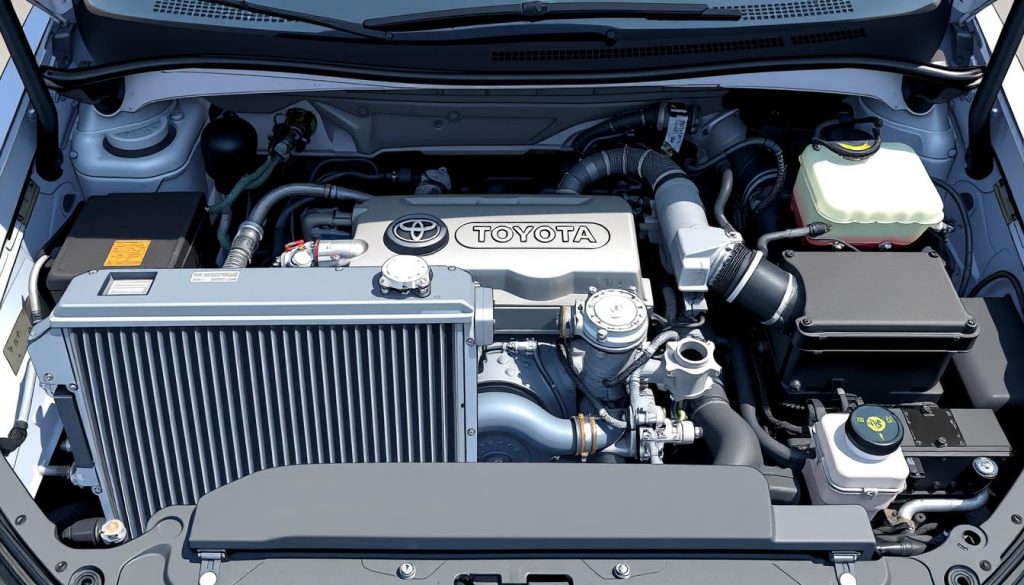
Radiator Problems and Fixes
Radiator issues are common in older Toyotas. Clogged fins reduce cooling. Clean them with compressed air or a soft brush. Avoid using high-pressure water as it can harm the fins.
Small leaks might be fixed with commercial sealants. But, these are only temporary fixes. For a lasting solution, you might need to replace the radiator or get it professionally fixed.
Water Pump Failures
The water pump is key for coolant circulation in your Toyota’s engine. Signs of failure include:
- Coolant leaking from the pump housing
- Whining or grinding noises from the front of the engine
- Overheating despite enough coolant
Replacing the water pump often means removing the timing belt. Unless you’re very skilled, it’s best to get a professional to do this.
Thermostat Issues and Replacement
The thermostat controls coolant flow based on engine temperature. A stuck closed thermostat overheats quickly. A stuck open one keeps the engine from reaching the right temperature.
Replacing the thermostat is easy on most Toyotas and is cheap. Make sure to use the correct temperature-rated thermostat for your vehicle. This ensures your engine runs well and prevents overheating.
Seasonal Considerations for Your Toyota’s Cooling System
As the seasons change, your Toyota’s cooling system needs extra care. This is to avoid breakdowns and keep your engine running smoothly. Your car faces different challenges with each season, so it’s important to adjust your maintenance routine accordingly.
Summer Preparation and Heat Management
When it gets hot, your Toyota’s cooling system works hard to keep it cool. Start by checking all cooling parts, especially hoses that might have gotten stiff in the cold.
Make sure your coolant is at the right mix of 50/50. Removing debris from radiator fins is key to keeping your car cool in the heat.
If your Toyota is older or has a lot of miles, get a coolant flush before summer. This helps protect your car from overheating, especially when it’s hottest.
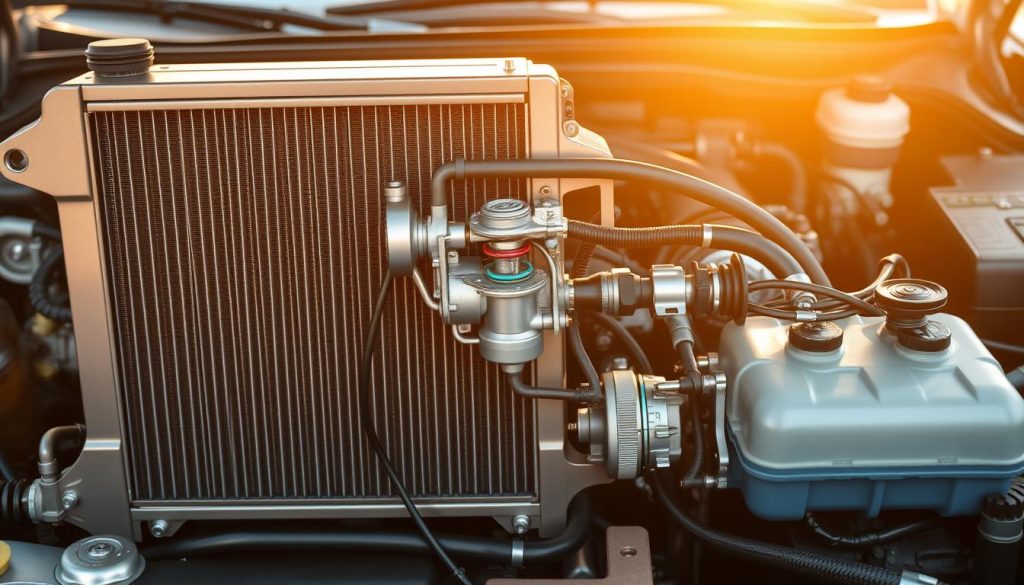
Winter Protection Against Freezing
In winter, keeping your coolant from freezing is crucial. Check its freeze protection level with a hydrometer. Most places need it to be at least -34°F.
In very cold areas, you might need even more antifreeze, but don’t go over 70%. Also, make sure your heater is working right, as it needs the cooling system to function.
Regularly check your thermostat. It’s important for your engine to warm up fast in cold weather. A stuck-open thermostat can make your car take longer to warm up and affect your heater.
Spring and Fall Check-ups
Spring and fall are great times for a thorough cooling system check. In spring, look for damage from winter, like cracked hoses or radiator problems from road salt.
In fall, get your system ready for winter. Make sure it’s protected from freezing before the cold weather hits. These seasons are also good times for a full antifreeze service if you’re due for one.
| Season | Primary Focus | Key Maintenance Tasks | Special Considerations |
|---|---|---|---|
| Summer | Overheating prevention | Clean radiator fins, check coolant level, inspect hoses | Consider higher coolant concentration in extreme heat regions |
| Winter | Freeze protection | Verify antifreeze concentration, check thermostat, test heater | Adjust coolant ratio based on local temperature extremes |
| Spring | Winter damage assessment | Inspect for salt damage, check for leaks, test pressure cap | Look for stress cracks from freeze-thaw cycles |
| Fall | Winter preparation | Complete antifreeze service if needed, check belts, test coolant | Ideal time for system flush before winter stress |
DIY vs. Professional Toyota Coolant Service
Deciding between DIY and professional coolant service for your Toyota is important. It depends on your skills, time, and budget. The right choice ensures your car gets the care it needs without breaking the bank or taking too much of your time.
When to Do It Yourself
If you know a bit about cars and have the right tools, DIY coolant maintenance is for you. Simple tasks like checking coolant levels and topping it off are easy. You can also inspect hoses for wear.
Doing a coolant replacement yourself is possible if you have:
- Access to your Toyota’s service manual
- Proper disposal options for used coolant
- About 2-3 hours of free time
Going the DIY route can save you $70-$140 compared to getting it done professionally. It also lets you learn more about your car.
When to Seek Professional Help
- Complex repairs like water pump replacement
- Newer Toyota models with sophisticated cooling systems
- Hybrid vehicles with additional cooling circuits
- Unexplained cooling problems requiring diagnosis
If you don’t have a safe way to dispose of coolant, getting professional help is best. Also, professional service can help keep your Toyota’s value up by providing a documented service history.
Cost Comparison and Time Investment
DIY radiator flush costs $30-$60 for materials, plus any tool purchases. Professional service costs $100-$200 at dealerships and $75-$150 at independent shops.
Time-wise, DIY coolant service takes 2-3 hours for someone with some experience. This doesn’t include time to buy supplies and dispose of waste. Professional service is quicker, as you just drop off and pick up your car.
For many Toyota owners, the ease of professional maintenance is worth the extra cost. It’s especially true if you’re worried about making DIY mistakes. Either way, regular coolant maintenance is key to your car’s long life.
Advanced Cooling System Upgrades for Toyota Vehicles
Toyota owners looking to boost their cooling system have several options. These upgrades are great for those who tow heavy loads, go off-roading, or face extreme climates. They offer valuable benefits for your vehicle.
Performance Radiators
Installing a performance radiator is a top upgrade for your Toyota’s cooling system. These aftermarket parts outperform stock units with better design and materials.
They are made of aluminum, not copper/brass, for better heat dissipation and less weight. They also have thicker cores and more rows for better cooling.
Top brands like Koyo, Mishimoto, and CSF offer direct-fit radiators for Toyotas like Tacoma, 4Runner, Tundra, and Supra. These upgrades are perfect for demanding conditions like towing, off-roading, or hot driving.
Electric Fan Conversions
Electric fan conversions are a great upgrade, especially for older Toyotas with mechanical fans. Electric fans cool consistently, unlike mechanical fans that cool less at low RPMs.
They also save horsepower that mechanical fans use. This is especially helpful in city driving where mechanical fans are less effective.
SPAL and Flex-a-lite make kits for many Toyotas. These kits include fans, mounts, controllers, and wiring. They’re great for older Tacoma, 4Runner, and Land Cruiser models.
High-Flow Water Pumps
The water pump is key to your Toyota’s cooling system. Upgrading to a high-flow pump improves coolant flow, reducing hot spots and ensuring better cooling.
Stewart Components and Meziere make pumps with better impellers. They increase coolant flow by 15-30% over stock pumps. This is great for severe duty or modified engines.
High-flow pumps are common in performance cars but also help in tough conditions. They’re easy to install, making them a good DIY project for car enthusiasts.
Coolant Additives: Fact vs. Fiction
The market is full of coolant additives claiming big improvements. But, it’s key to know what’s real. Some additives offer small benefits, while others make false claims.
Water wetter products, like Red Line, can slightly improve cooling. They reduce surface tension for better contact between coolant and metal. But, the temperature drops are usually small, just a few degrees.
Coolant system sealers should be viewed with caution. They might fix small leaks temporarily but are not a long-term solution. They can clog small passages in your cooling system over time.
Most experts agree that using the right Toyota coolant, mixed correctly and changed on time, beats any additive. Be careful of products that promise big temperature drops without explaining how.
| Upgrade Type | Cost Range | Installation Difficulty | Best For | Expected Benefits |
|---|---|---|---|---|
| Performance Radiator | $200-$600 | Moderate | Towing, off-roading, hot climates | 10-15°F lower operating temperatures |
| Electric Fan Conversion | $150-$450 | Moderate to Difficult | City driving, older Toyotas | Better cooling at idle, 3-5 HP gain |
| High-Flow Water Pump | $100-$350 | Moderate | Modified engines, severe duty | 15-30% increased coolant flow |
| Coolant Additives | $10-$30 | Easy | Temporary solutions | Minimal (2-3°F) to negligible |
Before getting any cooling system upgrade for your Toyota, think about your needs and driving conditions. These upgrades are great in certain situations but not for normal driving with a well-maintained stock system.
For the best results, talk to Toyota specialists who know your model. They can suggest the most valuable upgrades and ensure they’re installed right for maximum benefit.
Environmental Considerations and Proper Disposal
Responsible Toyota owners know that antifreeze service goes beyond just car maintenance. It also means disposing of hazardous materials properly. Used coolant has toxic chemicals and heavy metals that can harm the environment if not disposed of correctly.
Why Coolant Recycling Matters
Ethylene glycol coolant is very toxic to humans, animals, and the environment. Just one gallon can pollute up to 1 million gallons of water. Its sweet taste and smell attract pets and wildlife, often leading to death.
Used coolant also has heavy metals like lead, copper, and aluminum. These metals come from your Toyota’s cooling system. The good news is that up to 98% of used coolant can be recycled and reused.
Finding Local Disposal Facilities in the U.S.
In the United States, you have many options for disposing of coolant properly. Most counties have facilities for household hazardous waste, including automotive fluids. Auto parts stores like AutoZone, Advance Auto Parts, and O’Reilly Auto Parts also offer free coolant recycling.
Some Toyota dealerships will take used coolant, especially if you buy new coolant from them. For local options, Earth911.com has a database by ZIP code and material type.
Eco-Friendly Coolant Options
For those who care about the environment, there are less toxic coolants available. Brands like Prestone, Peak, and Zerex offer these options. They work well in Toyota vehicles.
When choosing an eco-friendly coolant for your next coolant replacement, make sure it fits your Toyota model. Remember, even eco-friendly coolants need proper disposal. Never pour automotive fluids down drains or on the ground, no matter their toxicity level.
Toyota Coolant System Care for High-Mileage Vehicles
High-mileage Toyotas need special care for their coolant systems to last long. Toyota is known for making cars that go over 200,000 miles. But, keeping these cars running well requires careful maintenance, especially for the cooling system.
Special Considerations for Vehicles Over 100,000 Miles
When your Toyota hits 100,000 miles, cooling system care becomes crucial. At this point, parts may start to wear out faster.
The coolant’s protective additives wear off quickly, even with Toyota’s long-life coolants. Think about flushing your coolant more often, like every 30,000 miles instead of 100,000.
Rubber parts in the cooling system need extra attention in older Toyotas. Hoses, gaskets, and seals get brittle from heat and chemicals. Regularly check these parts.
The water pump, untouched for years, should be checked carefully. Many owners replace it during timing belt service, around 90,000-100,000 miles. Changing engine coolant at this time is a good maintenance chance.
Addressing Age-Related Cooling System Issues
Older Toyotas often face cooling system problems. Watch out for these common issues:
- Radiator seam leaks or internal corrosion that may not be immediately visible
- Partially clogged heater cores reducing heating efficiency
- Thermostats that stick intermittently, causing temperature fluctuations
- Weakened radiator cap pressure seals leading to coolant loss
- Electric cooling fans with degraded temperature sensors causing improper operation
Fixing these problems early saves money and prevents breakdowns. A full radiator flush can remove harmful deposits.
Preventative Measures for Older Toyota Models
Strategic steps can extend your Toyota’s cooling system life. Consider a full cooling system overhaul between 125,000-150,000 miles. Replace the radiator, hoses, thermostat, water pump, and coolant together.
This approach is often cheaper than fixing parts as they fail. Always choose OEM or high-quality aftermarket parts for Toyota vehicles.
Make cooling system checks part of your oil change routine. Look for leaks, check coolant level, and inspect the coolant’s condition. Some owners use coolant filters to keep the coolant clean and last longer.
For Toyotas with cooling system issues (like some 1990s models with 3.0L V6 engines), look up model-specific advice from Toyota experts. With the right care, your high-mileage Toyota can keep running well for years.
Conclusion: Keeping Your Toyota Running Cool for Years to Come
A well-maintained Toyota Coolant System is key to your vehicle’s health. By following this guide, you can keep your Toyota at the right temperature. Regular checks are quick but can save a lot of money.
Remember, your Toyota model has its own coolant needs. The right coolant type, like pink or red, is important for your system’s life. Always follow your owner’s manual for when to flush the coolant, usually every 30,000-50,000 miles.
Watch for signs like temperature changes, sweet smells, or leaks. These signs can show problems before they get worse. For Toyotas with a lot of miles, check hoses, the radiator, and water pump more often.
Investing time and money in your Toyota’s Coolant System pays off big. It helps your engine last longer, saves fuel, and keeps your car running well. With the right care, your Toyota can go over 200,000 miles without trouble.
Your Toyota was made to last. With the right coolant care, it will stay cool and strong for years.
FAQ
How often should I change the coolant in my Toyota?
For most Toyotas with Toyota Super Long Life Coolant, change it at 100,000 miles first. Then, do it every 50,000 miles after that. If your Toyota is older or uses regular coolant, change it every 30,000-50,000 miles. Always check your owner’s manual for the exact time, as it varies by model and year.
What color is Toyota coolant supposed to be?
Toyota Super Long Life Coolant, used in most Toyotas since 2004, is pink or red. Older Toyotas might use Toyota Long Life Coolant, which is also red. If your coolant looks rusty, brown, or has particles, it’s bad and needs to be changed, no matter the color.
Can I mix different types of coolant in my Toyota?
No, mixing coolants is a bad idea. Different coolants can react badly and damage your cooling system. Always use the coolant type recommended for your Toyota. If unsure, check your owner’s manual or talk to a Toyota dealer.
What’s the correct coolant-to-water ratio for my Toyota?
The right mix is 50/50 coolant to water. This protects against freezing up to -34°F and boiling up to 265°F. In very cold areas, you might need a 60/40 mix for more freeze protection. Never use more than 70% coolant, as it can hurt cooling efficiency.
What are the signs that my Toyota’s cooling system needs attention?
Look out for a high or fluctuating temperature gauge, coolant leaks, or a sweet smell. Also, listen for gurgling or hissing sounds, poor engine performance, or a bad heater. If you see any of these signs, get your Toyota checked right away.
Can I use tap water instead of distilled water when mixing coolant?
No, tap water is not good for mixing coolant. It has minerals and impurities that can cause problems in your cooling system. These can lead to overheating over time.
Is it safe to drive my Toyota if it’s overheating?
No, driving an overheating Toyota can damage your engine badly. It can warp cylinder heads, crack engine blocks, or blow head gaskets. If it overheats, pull over, turn off the engine, and let it cool down. In an emergency, turn on the heater at full blast to help cool the engine.
How do I properly dispose of used Toyota coolant?
Don’t pour used coolant down drains or into waterways. It’s toxic to humans, animals, and the environment. Store it in sealed containers and take it to places that recycle fluids. You can find local disposal options on Earth911.com.
Should I use OEM Toyota coolant or is aftermarket coolant acceptable?
Toyota OEM coolants are best for your engine. They offer the right protection. While they might cost more, they’re worth it for long-term protection. If you choose aftermarket coolant, make sure it meets Toyota’s standards for your model.
What’s the difference between a coolant flush and just topping off coolant?
Topping off coolant just adds more fluid without removing old coolant. A coolant flush drains old coolant, cleans the system, and adds new coolant. Flushes are needed at service intervals to remove contaminants and replace corrosion inhibitors.
Do Toyota hybrid models have different coolant requirements?
Yes, Toyota hybrids like the Prius have special cooling systems. They manage both the engine and electric parts. They might need specific coolants or service procedures. Always check your hybrid’s manual for the right coolant and maintenance for your model.
What should I do if I notice a coolant leak in my Toyota?
If you see a coolant leak, first check the level when the engine is cool. Add coolant if it’s low. Then, look for leaks in the radiator, hoses, water pump, and other parts. Small leaks might be fixed with sealants, but big leaks need a professional check.
How much does a Toyota coolant flush typically cost?
A DIY coolant flush costs about – for materials and tools. Professional service at a Toyota dealership costs 0-0. Independent shops might charge -0. Prices depend on your Toyota, location, and any extra work needed.
Are there any cooling system upgrades worth considering for my Toyota?
For Toyotas used in tough conditions, consider upgrades like performance radiators or electric fan conversions. These can improve cooling. But for normal use, sticking with the stock system is usually best.
What special coolant system care does my high-mileage Toyota need?
High-mileage Toyotas need more coolant changes (every 30,000 miles) and checks on rubber parts. Replace the water pump during timing belt service. Also, watch for radiator leaks and thermostat issues. A cooling system overhaul might be needed between 125,000-150,000 miles.
